Transforming Legacy Java-based Enterprise Applications: 10 Frameworks to Know
- June 13
- 23 min

The Spring Framework serves as a comprehensive programming and configuration model for modern Java-based enterprise applications. Its primary goal is to simplify the development of large-scale, complex systems by providing a robust infrastructure foundation. Instead of developers writing extensive boilerplate code for common enterprise tasks like object lifecycle management, transaction handling, or security, Spring offers pre-built, configurable components. It enables developers to focus on application-specific business logic, leveraging Plain Old Java Objects (POJOs) and relying on the framework to manage dependencies and integrate various enterprise services. This approach significantly enhances developer productivity and promotes building modular, testable, and maintainable applications, making it a de facto standard in the enterprise Java ecosystem.
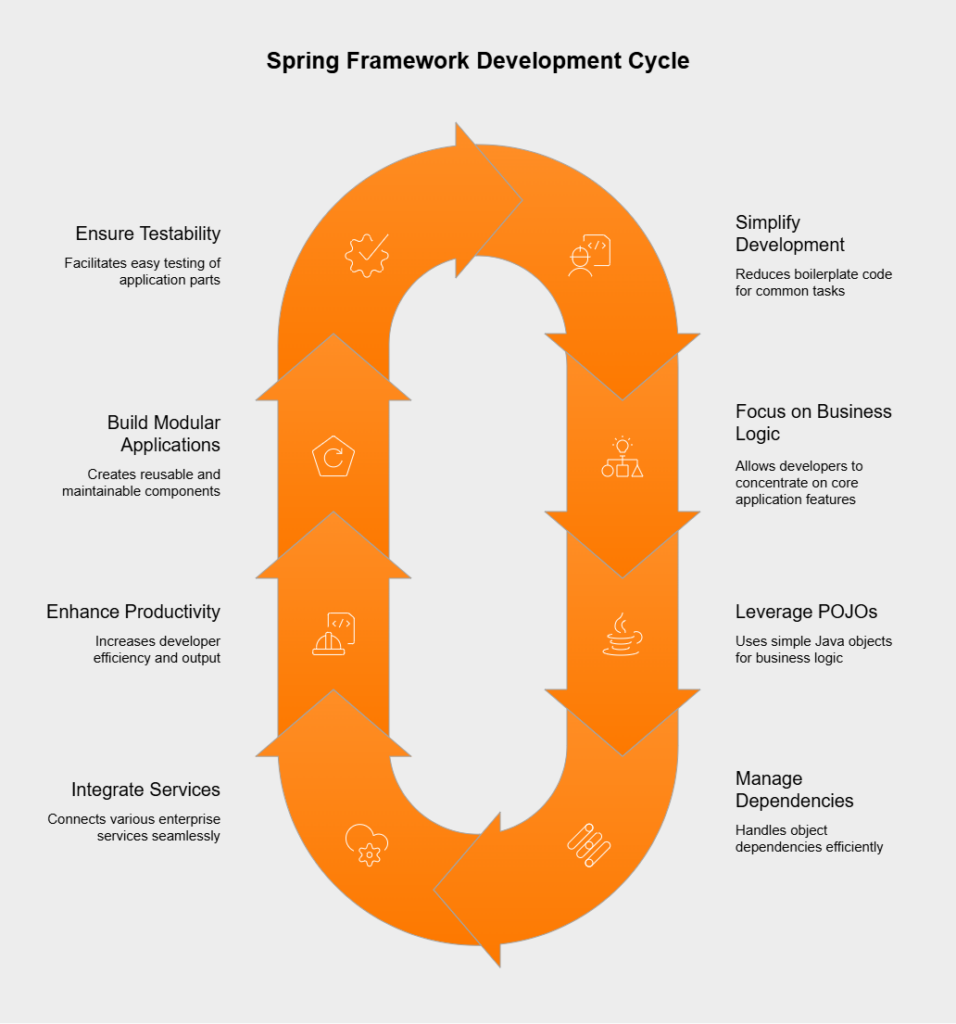
Inversion of Control (IoC) is a fundamental principle in Spring that fundamentally changes how software components interact. Traditionally, a component would create or locate its own dependencies (other objects it needs to function). With IoC, this control is inverted: the responsibility of creating, configuring, and assembling objects (known as Spring Beans) is delegated to an external container, typically Spring’s ApplicationContext. Developers simply define the beans and their dependencies (often through configuration metadata like annotations or XML), and the IoC container injects these dependencies into the components when needed. This drastically simplifies development by decoupling components, making them easier to manage, test independently, and reuse across different parts of the application. It removes the need for components to manage complex object lookups or factories.
Dependency Injection (DI) is the primary mechanism through which Inversion of Control is implemented in Spring. It offers several key advantages for enterprise Java development. Firstly, it promotes loose coupling between components; objects don’t need to know how their dependencies are created or implemented, only that they conform to a specific interface. This makes the system more flexible and easier to modify or extend. Secondly, DI significantly enhances testability. Dependencies can be easily swapped with mock or stub implementations during unit testing, allowing components to be tested in isolation without relying on the entire system infrastructure. Thirdly, DI centralizes the configuration of components and their relationships, improving the overall maintainability and understandability of the application’s architecture. Common DI mechanisms in Spring include constructor injection, setter injection, and field injection (often using the @Autowired annotation).
// Example of Constructor Injection
@Component
public class MyService {
private final MyRepository repository;
// Spring injects the dependency via the constructor
@Autowired
public MyService(MyRepository repository) {
this.repository = repository;
} // Business logic using the repository
public void performAction() {
repository.saveData();
}
}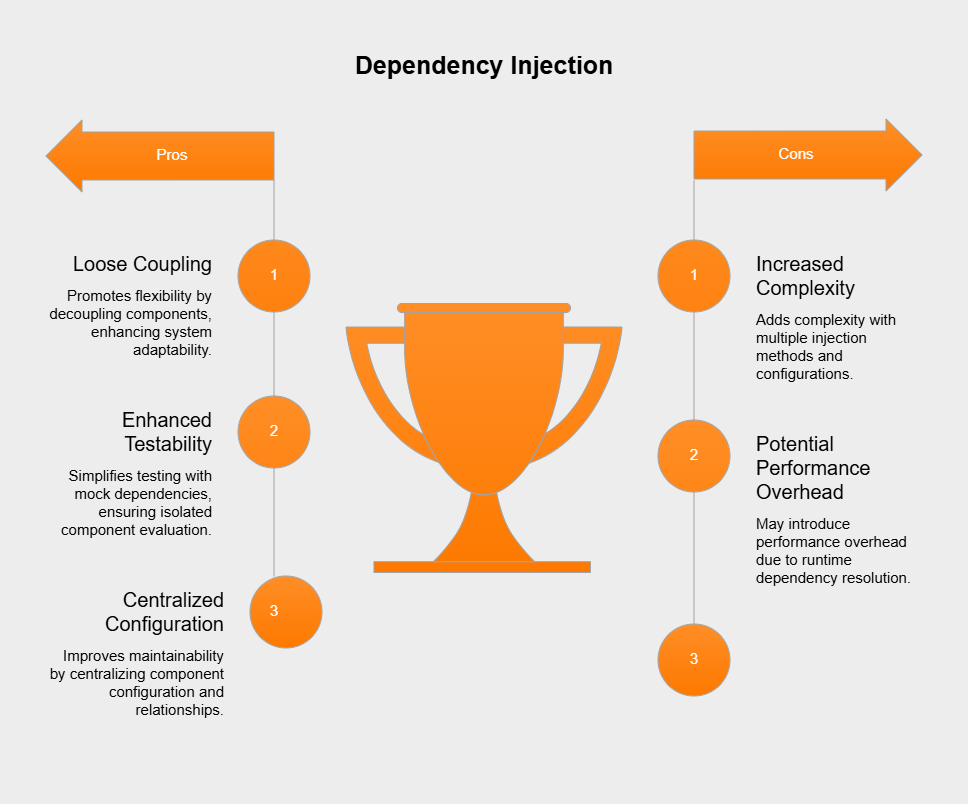
Aspect-Oriented Programming (AOP) complements Object-Oriented Programming (OOP) by providing another way of thinking about program structure. While OOP focuses on decomposing applications into a hierarchy of objects, AOP focuses on modularizing cross-cutting concerns – aspects of a program that affect multiple points in an application. Examples include logging, security checks, transaction management, and caching. In traditional development, code for these concerns often gets scattered across many modules, leading to code duplication and tangling. Spring AOP allows developers to define these concerns in separate modules called aspects. These aspects can then be declaratively applied to specific points in the code execution (known as join points) without modifying the core business logic code itself. This leads to cleaner, more modular code where business logic remains uncluttered by infrastructure concerns, improving maintainability and reducing redundancy.

The Spring ecosystem consists of numerous projects built upon the core framework, each designed to address specific areas of enterprise application development. Leveraging these projects significantly streamlines the creation of robust, scalable, and maintainable systems.
Spring Boot radically simplifies the process of creating stand-alone, production-grade Spring-based applications. It makes opinionated choices about dependencies and configuration, providing sensible defaults that work “out of the box”. Key features include auto-configuration (automatically configuring the application based on JAR dependencies present), embedded servers (like Tomcat, Jetty, or Undertow), and production-ready metrics, health checks, and externalized configuration. This allows developers to get applications up and running with minimal setup.
Spring MVC is a mature and flexible web framework built on the Servlet API. It implements the Model-View-Controller design pattern, providing a clean separation between application logic, presentation (views), and request handling (controllers). It offers powerful features for building traditional web applications with various view technologies (like Thymeleaf or JSP) as well as modern RESTful APIs using annotations like @RestController and @RequestMapping.
Spring Data aims to simplify data access layers by providing a consistent programming model across different persistence technologies. Whether using relational databases (via JDBC or JPA/Hibernate), NoSQL databases, or other data stores, Spring Data offers abstractions like the Repository pattern. This significantly reduces the amount of boilerplate code required for common data operations (CRUD – Create, Read, Update, Delete) and query execution.
Spring Security is a powerful and highly customizable framework focused on providing both authentication (verifying who a user is) and authorization (determining what a user is allowed to do). It offers comprehensive protection against common security threats and integrates seamlessly with various authentication mechanisms (like form-based login, OAuth2, LDAP, SAML) and authorization strategies (role-based access control, permissions).
For applications requiring robust processing of large volumes of data, Spring Batch provides a lightweight, comprehensive batch framework. It supports reusable functions for reading, processing, and writing data, along with features critical for batch operations like transaction management, job processing statistics, job restart, skipping, and resource management. It’s ideal for ETL (Extract, Transform, Load) tasks, complex calculations, and data migration.
Spring Integration enables lightweight messaging within Spring-based applications and supports integration with external systems via declarative adapters. It implements well-known Enterprise Integration Patterns (EIPs), facilitating the development of event-driven architectures and enabling communication between different application components or microservices using concepts like messages, channels, and endpoints. It simplifies integration with protocols like JMS, AMQP (RabbitMQ), Kafka, FTP, HTTP, and more.
Spring provides flexible ways to configure the application context, define beans, and manage dependencies. Developers can choose the approach that best suits their project needs or even combine different methods.
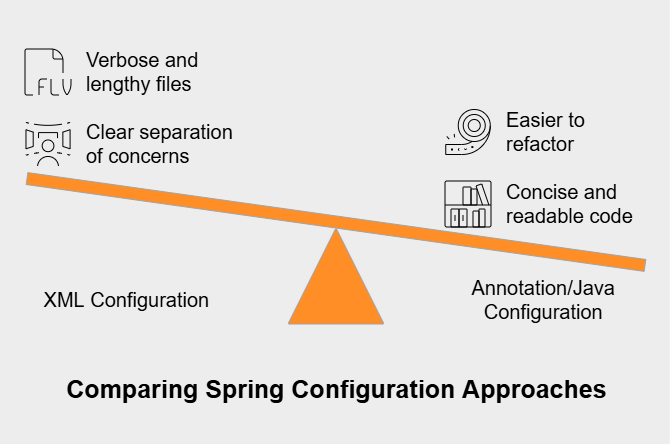
This is currently the most popular approach. Developers use annotations directly within their Java classes to define beans and their dependencies. Key annotations include @Component (and its specializations @Service, @Repository, @Controller, @RestController), @Autowired for dependency injection, @Configuration to mark configuration classes, and @Bean to declare beans programmatically within configuration classes. This method keeps configuration close to the source code it configures.
JavaConfig allows developers to define Spring configuration entirely using Java code, typically within classes annotated with @Configuration. Methods annotated with @Bean within these classes return instances of objects that are registered as Spring beans in the application context. This approach offers type safety, better refactoring support compared to XML, and the full power of the Java language for defining configuration logic.
@Configuration
public class AppConfig {
@Bean
public MyRepository myRepository() {
return new DatabaseRepository(); // Example implementation
}
@Bean
public MyService myService(MyRepository repository) {
// Dependencies can be injected via method parameters
return new MyServiceImpl(repository);
}
}Historically, XML was the primary way to configure Spring applications. Beans, dependencies, aspects, and other configurations were defined in XML files (typically named like `applicationContext.xml`). While less common for new projects compared to annotation or Java-based configuration, XML configuration is still supported and can be useful for configuring certain infrastructure components or integrating with legacy systems. It provides a clear separation between configuration and Java code but can become verbose and harder to refactor.
Spring MVC provides excellent support for building RESTful web services, which are crucial for modern enterprise applications and microservice architectures. Developers typically use the @RestController annotation (a convenience annotation combining @Controller and @ResponseBody) on a class to indicate that it handles incoming web requests and returns data directly in the response body (usually serialized as JSON or XML), rather than rendering a view. Methods within the controller are mapped to specific HTTP methods (GET, POST, PUT, DELETE) and URL paths using annotations like @GetMapping, @PostMapping, @PutMapping, @DeleteMapping, and the more general @RequestMapping. Path variables (@PathVariable), request parameters (@RequestParam), and request bodies (@RequestBody) are easily accessed through method parameters. Spring handles the marshalling and unmarshalling of data automatically using integrated message converters (like Jackson for JSON).
@RestController
@RequestMapping("/api/products")
public class ProductController {
// Assume ProductService is injected via constructor
@GetMapping("/{id}")
public ResponseEntity getProductById(@PathVariable Long id) {
Product product = productService.findById(id);
if (product != null) {
return ResponseEntity.ok(product);
} else {
return ResponseEntity.notFound().build();
}
} @PostMapping
public ResponseEntity createProduct(@RequestBody Product newProduct) {
Product createdProduct = productService.save(newProduct);
return ResponseEntity.status(HttpStatus.CREATED).body(createdProduct);
}
}Spring Data significantly simplifies data access by offering consistent abstractions over various persistence technologies. It reduces boilerplate code and allows developers to focus on data modeling and querying.
For developers who prefer working directly with SQL, Spring provides the JdbcTemplate class. It handles resource management (like opening and closing connections), exception translation to Spring’s consistent data access exception hierarchy, and simplifies the execution of SQL queries and updates. While it requires writing SQL statements manually, it offers fine-grained control over database interactions and avoids the complexities of ORM frameworks.
Spring Data JPA is a popular module that builds upon the Java Persistence API (JPA) standard, commonly implemented using Object-Relational Mapping (ORM) frameworks like Hibernate. Spring Data JPA provides repository abstractions (interfaces like JpaRepository) where developers define query methods simply by declaring their signatures. Spring automatically generates the necessary implementation and query logic based on method naming conventions or using the @Query annotation. This drastically reduces the amount of data access code needed for CRUD operations and custom queries.
// Example Spring Data JPA Repository
public interface ProductRepository extends JpaRepository {
// Spring Data generates the query implementation based on the method name
List findByCategory(String category);
@Query("SELECT p FROM Product p WHERE p.price > :minPrice")
List findProductsAbovePrice(@Param("minPrice") BigDecimal minPrice);
}Spring provides powerful support for transaction management, abstracting away the complexities of underlying transaction APIs (like JDBC, JPA/Hibernate, or JTA). The most common approach is declarative transaction management using the @Transactional annotation. By applying this annotation to methods or entire classes, developers can specify transactional boundaries and behaviors (like propagation level, isolation level, and rollback rules) without writing explicit transaction handling code (e.g., `try-catch-finally` blocks for `commit` or `rollback`). Spring AOP intercepts calls to annotated methods, automatically starting a transaction before the method executes and committing or rolling it back afterward based on the outcome. This significantly simplifies transaction logic and keeps business code clean.
@Service
public class OrderService {
// Assume orderRepository and inventoryService are injected
@Transactional // Spring manages the transaction boundary
public Order placeOrder(OrderRequest request) {
// Multiple operations within one transaction
Order order = orderRepository.save(request.getOrderDetails());
inventoryService.decreaseStock(request.getProductId(), request.getQuantity());
// If inventoryService throws an exception, the transaction rolls back
return order;
}
}Spring Security provides a comprehensive suite of tools for securing enterprise applications. For authentication (verifying identity), it supports a wide range of mechanisms including:
For authorization (controlling access), Spring Security enables fine-grained control based on roles, permissions, or custom rules. Common strategies include:
@PreAuthorize, @PostAuthorize, @Secured directly on service methods to enforce access rules before or after method execution.It handles session management, CSRF (Cross-Site Request Forgery) protection, and integrates seamlessly with Spring MVC and other parts of the framework.
Testability is a core design principle of the Spring Framework. Its architecture, particularly the use of DI, makes it inherently easier to test application components both in isolation (unit tests) and within a larger context (integration tests).
Dependency Injection allows developers to easily provide mock or stub implementations of dependencies when unit testing a specific class (like a service or controller). Frameworks like Mockito integrate seamlessly with testing tools (like JUnit or TestNG) to create mock objects. This means a service class can be tested without needing a real database connection or a running web server, leading to fast and reliable unit tests focused purely on the component’s logic.
Spring provides dedicated testing support modules (like `spring-test`) for writing integration tests. These tests verify the collaboration between multiple components or test interactions with external systems like databases or web services. Annotations like @SpringBootTest can load the entire Spring application context or a slice of it. Tools like MockMvc allow testing web controllers without needing a running servlet container, simulating HTTP requests and asserting responses. For tests requiring a database, Spring can manage test-specific transaction rollbacks or integrate with embedded databases or tools like Testcontainers.
Spring Boot and Spring Cloud form a powerful combination for building distributed systems based on the microservices architectural style. Spring Boot simplifies the creation of individual, independently deployable microservices with embedded servers and minimal configuration. Spring Cloud builds upon Spring Boot, providing tools and frameworks that address the common challenges of distributed systems. Key Spring Cloud projects include:
Together, they provide a comprehensive platform for developing, deploying, and operating resilient and scalable microservice-based applications.
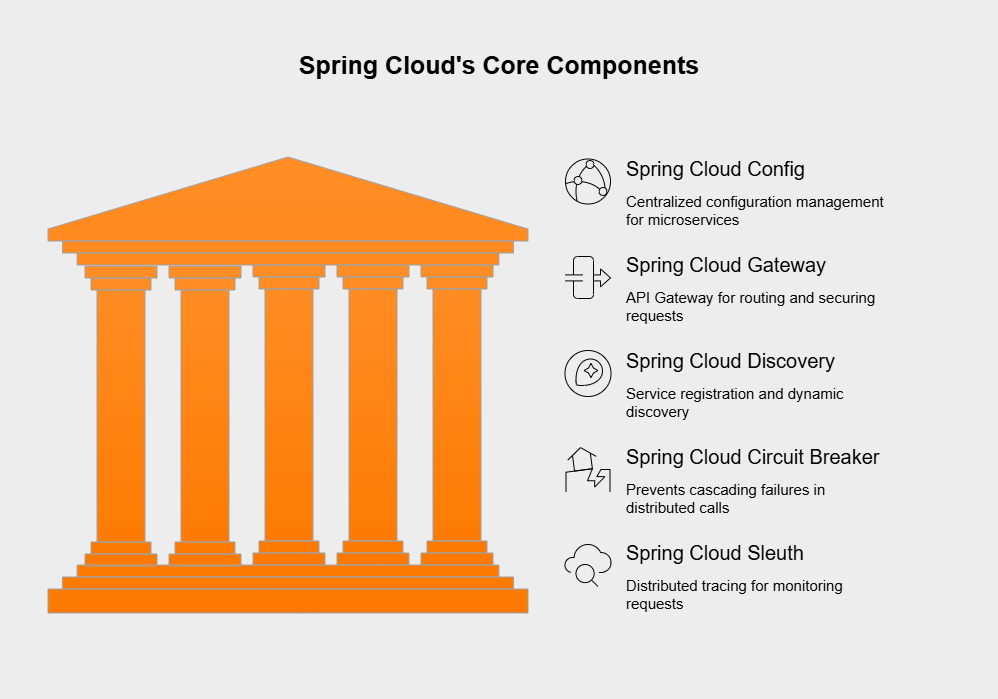
Spring WebFlux is a fully non-blocking, reactive web framework introduced in Spring Framework 5. Unlike the traditional servlet-based Spring MVC which uses a thread-per-request model, WebFlux is designed for reactive programming, utilizing event loops and non-blocking I/O. It supports reactive streams APIs (like Project Reactor’s Flux and Mono) for handling asynchronous data flows. WebFlux is particularly beneficial for applications that need high concurrency with fewer hardware resources, especially those involving I/O-bound operations like calling external services or interacting with reactive databases. It’s suitable for building highly scalable microservices, streaming APIs, and applications requiring low-latency responses under heavy load. However, it involves a different programming paradigm (reactive thinking) which can have a steeper learning curve compared to the imperative style of Spring MVC.
Leveraging the Spring Framework offers significant advantages for developing enterprise Java applications:
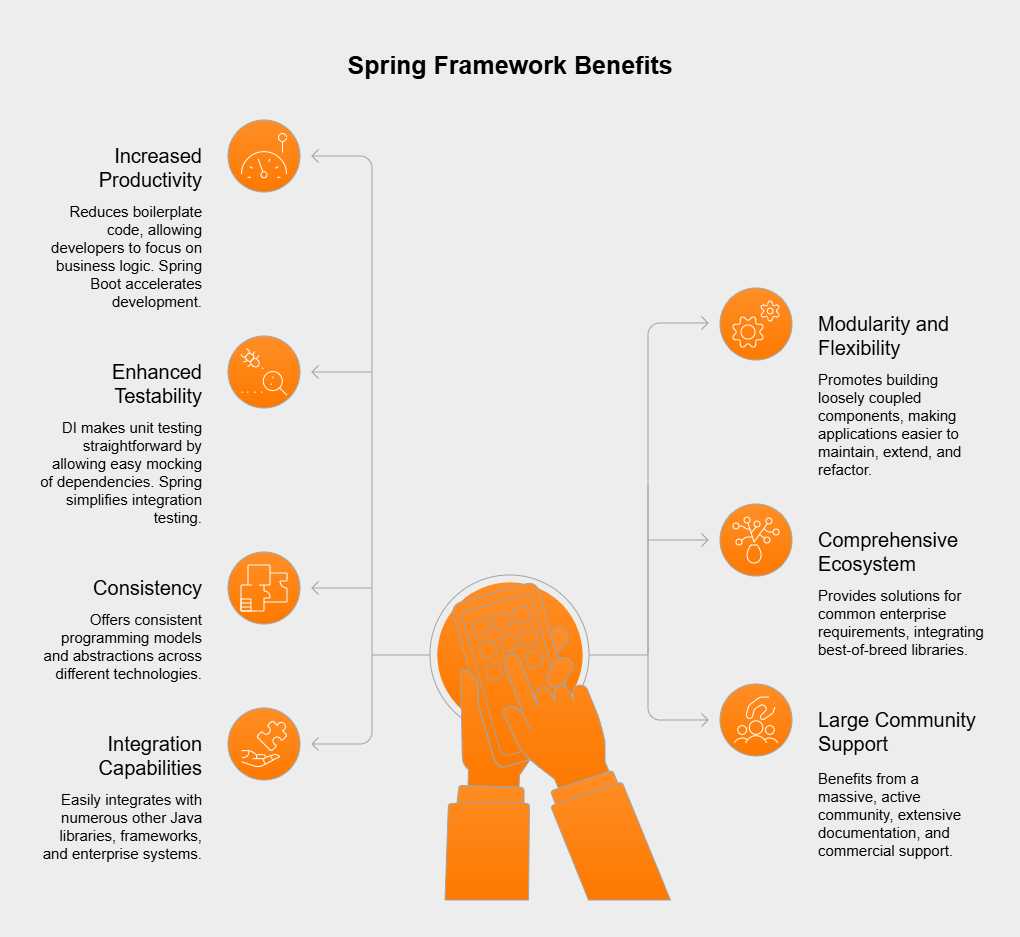
While powerful, using the Spring Framework effectively requires avoiding certain common pitfalls:

